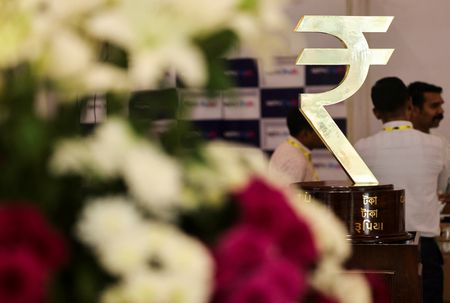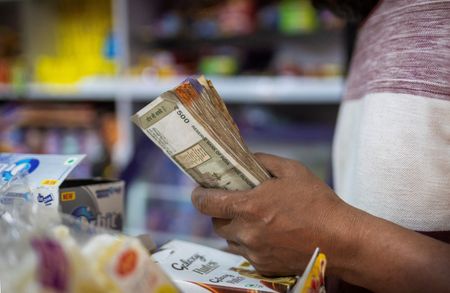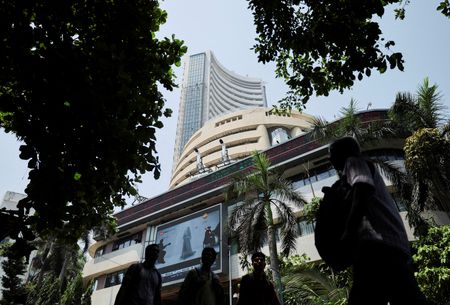By Jaspreet Kalra and Nimesh Vora
MUMBAI (Reuters) -Months of uncertainty over a U.S.-India trade deal have distorted India’s FX hedging landscape as expectations that the rupee may weaken further have amplified importer hedging while exporters hesitate, leaving the central bank to shoulder the resulting pressure on the currency.
Hefty U.S. tariffs on Indian goods went into effect in August and despite multiple rounds of talks, a deal has proven elusive. Both New Delhi and Washington, though, have said an agreement is within sight.
The delay has created a gulf in hedging activity that has hurt the rupee. Importer dollar hedging averaged about $43 billion a month between January and October, up 32% from its 2020–24 average, while exporter hedging has risen only 11% to $25 billion, per data from the Clearing Corporation of India.
The skew has thinned natural dollar supply and coincided with about $17 billion in equity outflows this year, prompting the Reserve Bank of India to intervene to bolster the rupee and offset one-sided dollar demand.
“Over recent months, there has been a notable decrease in hedging actions by exporters, while hedging activity by importers has remained robust,” said Sameer Karyatt, executive director and head of trading at DBS Bank India.
Thanks to consistent intervention, implied rupee volatility remains contained despite the currency hovering near its all-time low of 88.80 per dollar.
Since the level was first hit in September, the RBI has firmly defended it, anchoring expectations and ensuring that the strain on the currency does not spill over into the broader market.
The central bank’s heightened efforts to support the rupee have shown up in a $10 billion decline in foreign exchange reserves over the past month, while it has added to its short dollar forward positions for the first time in six months.
Despite this, the rupee, down 3.5% year-to-date, ranks among Asia’s weakest currencies in 2025.
UNCERTAIN PAYMENTS, RUPEE WEAKNESS EXPECTATIONS
Exporters seem reluctant to add hedges, anticipating further rupee weakness and facing uncertainty about the timing of payments from the United States.
“The view is that if he (the exporter) hedges now, he would receive only a small forward premium and risk missing out on the full depreciation that seems more or less inevitable in the current situation,” said Pankaj Chadha, managing partner at Mumbai-based Jyoti Steel Industries.
Exporters remain uncertain about both shipment volumes and the timing of payment receipts, according to Chadha, who also chairs the Engineering Export Promotion Council of India. This lack of clarity makes forward hedging difficult, he added.
Some exporters had sought a more favorable exchange rate from the central bank to convert their dollar earnings to rupees, Reuters reported in September, but the RBI is unlikely to agree, a source familiar with the matter said.
The RBI did not immediately respond to a request for comment.
U.S. tariffs have dented India’s exports to its largest market, with shipments falling to $5.43 billion in September from $6.87 billion in August.
(Reporting by Jaspreet Kalra, Nimesh Vora; Editing by Sonia Cheema)









